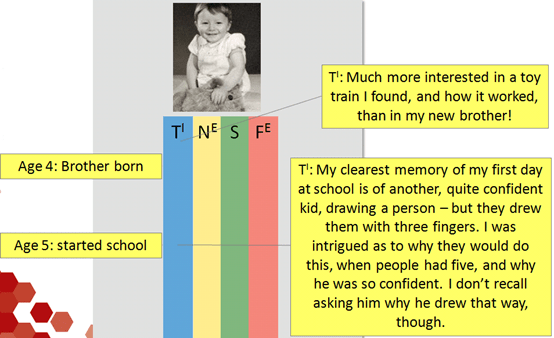Timelines and personality – tracking type in space and time
John Hackston - Head of R&D at OPP
One of the criticisms that people often level at the MBTI® questionnaire is that it ‘puts you in a box’. MBTI practitioners, however, know that this isn’t true – although we will have many similarities to people of the same type, there are also many ways in which we are unique. Whatever our underlying psychological type, we have all been brought up in different environments, and this will have a big influence on our personality and behaviour too.
Once we start talking about the ‘environment’, you may think of how you were brought up, what influence your siblings had on you, your schooling, the impact of past relationships; or you may be thinking about how your present circumstances are affecting you. What often goes unsaid here is that time is a big part of our environment. Different events happen to us at different points in our lives, and the effect they have on us depends on when they happen.
A good way of working out how life events have affected you (or one of your clients) is to write out a timeline. Take a blank sheet of paper, and draw a vertical line down the middle. Pin a picture of yourself as a baby at the top and a recent photo at the bottom. On the left side of the paper, list the important events that you believe have affected your personality, and on the right describe how each has affected you. Feel free to add notes, pictures, whatever works for you – once you start you may find you need several sheets of paper.
By mapping out your journey through life, a timeline can help you understand where you are now. But it can be much more powerful if you also bring in information about your personality. The MBTI gives us a map for how we are likely to develop, based on the dynamics of our type (if you are not familiar with type dynamics concepts, read the summary at the end of this article).
 Jung suggested that everyone has an inborn drive to develop and become the best version of themselves that they can be. This means that each type has its own path to lifelong development, starting with developing the dominant function; then (usually in our late teens) the auxiliary; then (in mid-life) the tertiary; and, finally, the fourth or ’inferior’ function.
Jung suggested that everyone has an inborn drive to develop and become the best version of themselves that they can be. This means that each type has its own path to lifelong development, starting with developing the dominant function; then (usually in our late teens) the auxiliary; then (in mid-life) the tertiary; and, finally, the fourth or ’inferior’ function.
This may sound a bit abstract, so I’m going to use myself as an example. My preferences are for INTP, so:
- My dominant function is Introverted Thinking (TI)
- My auxiliary function is Extraverted iNtuition (NE)
- My tertiary function is Sensing (S)
- My fourth or inferior function is Extraverted Feeling (FE)
What I can now do is to add my four functions to my timeline so as to understand myself better:

This would just be the beginning of my timeline; as I look at how I began to use my auxiliary, tertiary and inferior functions, I can see how I developed through my life so far – and where I might be headed. This can be extremely useful in coaching or career counselling, perhaps especially for those at midlife.
If this has whetted your appetite and you’d like to know more about using timelines, listen to our free webcast on the topic on the 1st of September at 2.30pm. If that's not a convenient time, don’t worry – we store all our webcasts on the OPP website, so you can listen at any time that suits you.
A brief explanation of type dynamics
In developing his theory of psychological type, upon which the MBTI instrument is founded, Carl Jung suggested that at any one time we might be doing one of two things:
- We might be taking in information from the environment, a process that Jung called Perceiving. There are two different ways in which we might do this:
- Sensing: taking in detailed real-life information from the external world or from our stored memories
- iNtuition: looking at connection, possibilities and the big picture
- OR we might be making a decision or judgment on the basis of this information, a process that Jung called Judging. Again, there are two different ways in which we might do this:
- Thinking: making the logical, rational decision
- Feeling: making a decision that takes into account our own and others’ values and feelings
We all use all four of these functions, but there will be one of these that we use and trust most (our dominant function), and one we use in a support role to the dominant (our auxiliary function). By adulthood, the goal is to have both these functions well developed so that we have a reliable way of taking in information and making decisions. In the second half of life, we integrate our less preferred functions (the ones that do not appear in our four-letter type code) – these are our tertiary function, and fourth or inferior function.
For more information on this area, Introduction to Type Dynamics and Development is a good starting point.